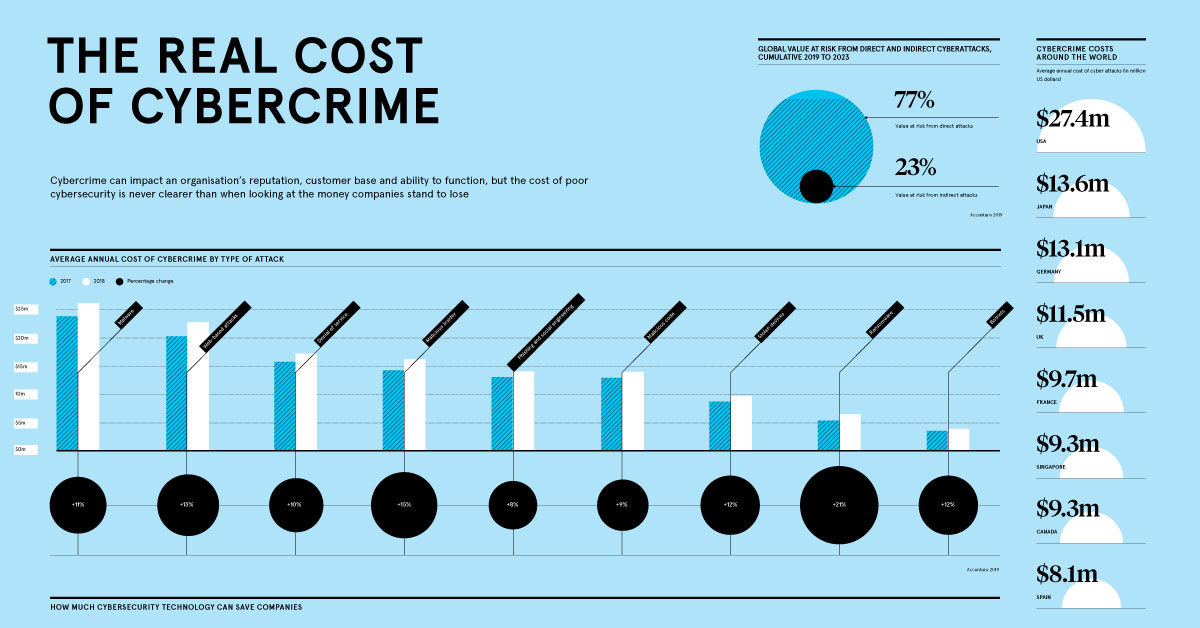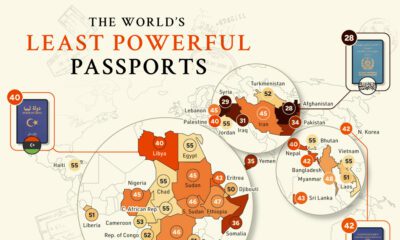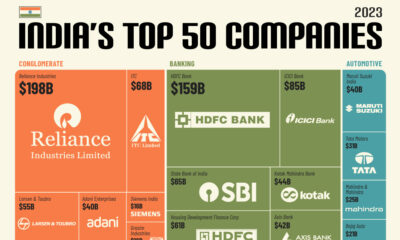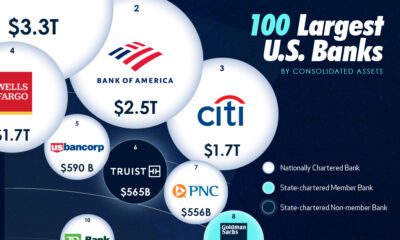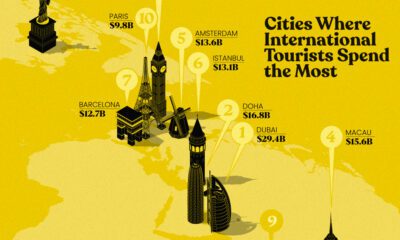Technology
Visualizing the Massive Cost of Cybercrime
View the full-size version of this infographic.
Visualizing the Massive Cost of Cybercrime
View the high resolution of this infographic by clicking here.
What do Equifax, Yahoo, and the U.S. military have in common? They’ve all fallen victim to a cyberattack at some point in the last decade—and they’re just the tip of the iceberg.
Today’s infographic from Raconteur delves into the average damage caused by cyberattacks at the organizational level, sorted by type of attack, industry, and country.
Rising Cybercrime Costs Across the Board
The infographic focuses on data from the latest Accenture “Cost of Cybercrime” study, which details how cyber threats are evolving in a fast-paced digital landscape.
Overall, the average annual cost to organizations has been ballooning for all types of cyberattacks. For example, a single malware attack in 2018 costed more than $2.6 million, while ransomware costs rose the most between 2017–2018, from $533,000 to $646,000 (a 21% increase).
Both information loss and business disruption occurring from attacks have been found to be the major cost drivers, regardless of the type of attack:
- Malware
Major consequence: Information Loss
Average cost: $1.4M (54% of total losses) - Web-based attacks
Major consequence: Information Loss
Average cost: $1.4M (61% of total losses) - Denial-of-Service (DOS)
Major consequence: Business Disruption
Average cost: $1.1M (65% of total losses) - Malicious insiders
Major consequences: Business Disruption and Information Loss
Average cost: $1.2M ($0.6M each, 75% of total losses)
In 2018, information loss and business disruption combined for over 75% of total business losses from cybercrime.
Cybercrime Casts a Wide Net
No industry is untouched by the growing cost of cybercrime—the report notes that organizations have seen security breaches grow by 67% in the past five years alone. Banking is the most affected, with annual costs crossing $18 million in 2018. This probably comes as no surprise, considering that financial motives are consistently a major incentive for hackers.
Here is the average cost of cyberattacks (per organization) across 15 different industries:
| Industry | 2017 Cost | 2018 Cost | % Change |
|---|---|---|---|
| Banking | $16.6M | $18.4M | +11% |
| Utilities | $15.1M | $17.8M | +18% |
| Software | $14.5M | $16M | +11% |
| Automotive | $10.7M | $15.8M | +47% |
| Insurance | $12.9M | $15.8M | +22% |
| High tech | $12.9M | $14.7M | +14% |
| Capital markets | $10.6M | $13.9M | +32% |
| Energy | $13.2M | $13.8M | +4% |
| U.S. Federal | $10.4M | $13.7M | +32% |
| Consumer goods | $8.1M | $11.9M | +47% |
| Health | $12.9M | $11.8M | -8% |
| Retail | $9M | $11.4M | +26% |
| Life sciences | $5.9M | $10.9M | +86% |
| Media | $7.6M | $9.2M | +22% |
| Travel | $4.6M | $8.2M | +77% |
| Public sector | $6.6M | $7.9M | +20% |
Interestingly, the impact on life sciences companies rose the most in a year (up by 86% to $10.9 million per organization), followed by the travel industry (up 77% to $8.2 million per organization). This is likely due to an increase in sensitive and valuable data being shared online, such as clinical trial details or credit card information.
So What Can Companies Do?
Accenture analyzed nine cutting-edge technologies that are helping mitigate cybercrime, and calculated their net savings: the total potential savings minus the required investment in each type of technology or tool.
With almost $2.3 million in net savings, many companies recognize the high payoff that comes with security intelligence. On the other hand, leveraging automation, artificial intelligence, and machine learning can potentially save over $2 million—however, only 38% of businesses have adopted this solution so far.
Cybercrime will remain a large-scale concern for years to come. From 2019–2023E, approximately $5.2 trillion in global value will be at risk from cyberattacks, creating an ongoing challenge for corporations and investors alike.
Technology
All of the Grants Given by the U.S. CHIPS Act
Intel, TSMC, and more have received billions in subsidies from the U.S. CHIPS Act in 2024.

All of the Grants Given by the U.S. CHIPS Act
This was originally posted on our Voronoi app. Download the app for free on iOS or Android and discover incredible data-driven charts from a variety of trusted sources.
This visualization shows which companies are receiving grants from the U.S. CHIPS Act, as of April 25, 2024. The CHIPS Act is a federal statute signed into law by President Joe Biden that authorizes $280 billion in new funding to boost domestic research and manufacturing of semiconductors.
The grant amounts visualized in this graphic are intended to accelerate the production of semiconductor fabrication plants (fabs) across the United States.
Data and Company Highlights
The figures we used to create this graphic were collected from a variety of public news sources. The Semiconductor Industry Association (SIA) also maintains a tracker for CHIPS Act recipients, though at the time of writing it does not have the latest details for Micron.
| Company | Federal Grant Amount | Anticipated Investment From Company |
|---|---|---|
| 🇺🇸 Intel | $8,500,000,000 | $100,000,000,000 |
| 🇹🇼 TSMC | $6,600,000,000 | $65,000,000,000 |
| 🇰🇷 Samsung | $6,400,000,000 | $45,000,000,000 |
| 🇺🇸 Micron | $6,100,000,000 | $50,000,000,000 |
| 🇺🇸 GlobalFoundries | $1,500,000,000 | $12,000,000,000 |
| 🇺🇸 Microchip | $162,000,000 | N/A |
| 🇬🇧 BAE Systems | $35,000,000 | N/A |
BAE Systems was not included in the graphic due to size limitations
Intel’s Massive Plans
Intel is receiving the largest share of the pie, with $8.5 billion in grants (plus an additional $11 billion in government loans). This grant accounts for 22% of the CHIPS Act’s total subsidies for chip production.
From Intel’s side, the company is expected to invest $100 billion to construct new fabs in Arizona and Ohio, while modernizing and/or expanding existing fabs in Oregon and New Mexico. Intel could also claim another $25 billion in credits through the U.S. Treasury Department’s Investment Tax Credit.
TSMC Expands its U.S. Presence
TSMC, the world’s largest semiconductor foundry company, is receiving a hefty $6.6 billion to construct a new chip plant with three fabs in Arizona. The Taiwanese chipmaker is expected to invest $65 billion into the project.
The plant’s first fab will be up and running in the first half of 2025, leveraging 4 nm (nanometer) technology. According to TrendForce, the other fabs will produce chips on more advanced 3 nm and 2 nm processes.
The Latest Grant Goes to Micron
Micron, the only U.S.-based manufacturer of memory chips, is set to receive $6.1 billion in grants to support its plans of investing $50 billion through 2030. This investment will be used to construct new fabs in Idaho and New York.
-

 Technology7 days ago
Technology7 days agoAll of the Grants Given by the U.S. CHIPS Act
-

 Misc2 weeks ago
Misc2 weeks agoHow Hard Is It to Get Into an Ivy League School?
-

 Debt2 weeks ago
Debt2 weeks agoHow Debt-to-GDP Ratios Have Changed Since 2000
-

 Sports2 weeks ago
Sports2 weeks agoThe Highest Earning Athletes in Seven Professional Sports
-

 Science2 weeks ago
Science2 weeks agoVisualizing the Average Lifespans of Mammals
-

 Brands1 week ago
Brands1 week agoHow Tech Logos Have Evolved Over Time
-

 Energy1 week ago
Energy1 week agoRanked: The Top 10 EV Battery Manufacturers in 2023
-

 Demographics1 week ago
Demographics1 week agoCountries With the Largest Happiness Gains Since 2010

